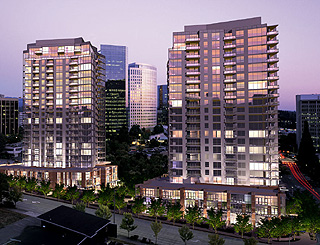
Surveys
DJC.COM
October 26, 2006
Retail plays a bigger role in mixed-use
CollinsWoerman

Image courtesy of CollinsWoerman Wasatch Development Associates’ Washington Square in Bellevue is a mixed-use project using retail elements to help define an urban lifestyle. It will have more than 150,000 square feet of retail amongst five condo towers, an office tower and a hotel. The first two condo towers, designed by CollinsWoerman, are under construction. |
The trend in real estate development toward mixed-use projects has been ongoing for some time. From Bangkok to Moscow to Puget Sound, people have come to recognize and enjoy the benefits of the right project mix and the synergy that can be created by integrating diverse yet complementary uses such as residential, office, entertainment, hotels and retail.
Urban dwellers, empty nesters leaving larger homes, baby boomers downsizing their lives and young professionals seeking quality-of-life can all find a sense of place within these environments. And as the number of mixed-use projects grows, so does the importance of understanding the role of retail and how an appropriate approach can help create a vibrant place to work, shop and live — in Seattle and beyond.
Creating vibrant districts
The most fundamental goal of any mixed-use project is to create a vibrant district for residents, workers and shoppers. The mix can grow, change and evolve, but the goal is always the same: To find that right combination of shopping, dining and entertainment to define the sense of community associated with the project.
Feedback from focus groups confirms what we intuitively know: That we all share the desire to live in a special place that helps define who and what we are. A sense of place and community is typically the number one attribute that people are looking for — and good shopping and dining is typically a close second. The caliber of these combined elements can define the quality of life associated with the project, even more than that of its residential or office uses.
The right retail approach
The right retail approach varies depending upon the nature of a mixed-use project, but the fundamental elements to success are the same. Residents respond to spaces that are pedestrian friendly — providing a sense of openness and accessibility, a feeling of light and space, of visual dynamism and diversity. A feeling of excitement and entertainment is key.
Architecturally, these elements can include anything from terraced outdoor plazas, common pedestrian corners and walkways to strong design elements such as high storefronts with tall glass for window-shopping or an eclectic mix of small or large shops.
Ultimately, well-designed retail areas contribute to the sense of place and community and provide a memorable experience that leaves a positive feeling in the visitor or resident. This contrasts heavily with the patchwork retail feel of the past.
The results of the right approach can be astounding. Today, the impact of a successful retail strategy in a mixed-use project can often make the difference between a successful or failed project. Developers and jurisdictions have long understood the benefits of increased lease revenues and sales tax revenues associated with successful retail, but now they are starting to see large increases in the residential values of mixed-use projects where a successful retail strategy and tenant mix has been incorporated into the project.
From urban to suburban
With more than 30 mixed-use projects planned for downtown Seattle, there are tremendous opportunities to create many new diverse neighborhoods and communities where people can work, shop and play in the same area they live.
Done well, these projects have the potential to transform our downtown neighborhoods and beyond. The trend toward high-density mixed-use projects is not confined to Seattle and Bellevue. We are seeing a rising demand for projects that incorporate the density, character and feel of an urban core area into suburban areas and smaller cities.
We are experiencing a sea change in the way people want to live, as residents outside our downtown cores are also responding strongly to this type of project that offers the opportunity to enjoy an urban lifestyle without having to travel downtown.
As the size and number of retail mixed-use projects planned for the Puget Sound area continues to grow, we have a tremendous opportunity to use these projects to transform both our downtown and suburban areas. When planning and design is met with a flexible approach and smart retail strategy, we can create meaningful, vibrant communities.
Scott Brown is an architect at CollinsWoerman, one of the region’s largest architecture, planning and interior design firms.
Other Stories:
- Victoria project goes from brown to green
- Should design firms grow and change?
- In with the old, in with the new
- Designers bet urban dwellers want more
- Dream team designs downtown penthouses
- Designing a cancer center for 4 competitors
- Healthy buildings’ role in organic modernism
- Queen Anne readies for icons old and new
- Keeping the bad guys out of banks
- Surviving today’s tough bid climate
- Why marketing during the good times is critical
- Getting creative with your feasibility analyses
- Hotels and condos: mixed-use matrimony
- School’s design reflects its humanist curriculum
- Seattle’s waterfront: 100 years of hidden history
Copyright ©2009 Seattle Daily Journal and DJC.COM.
Comments? Questions? Contact us.